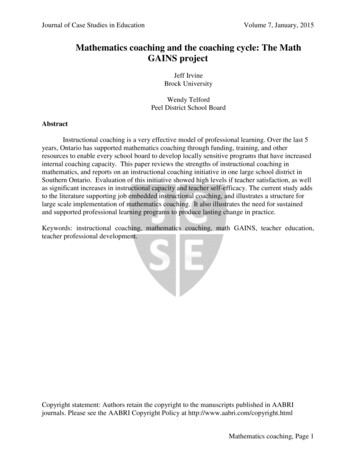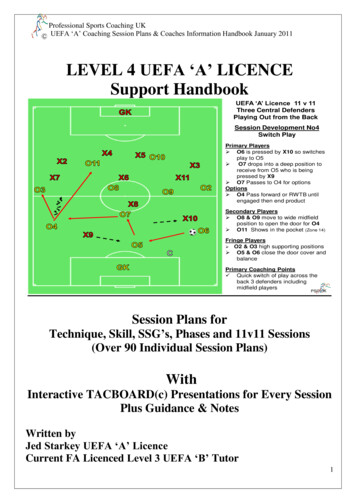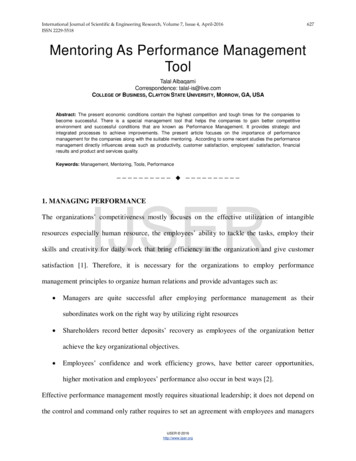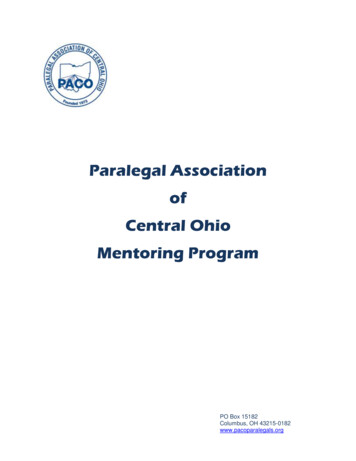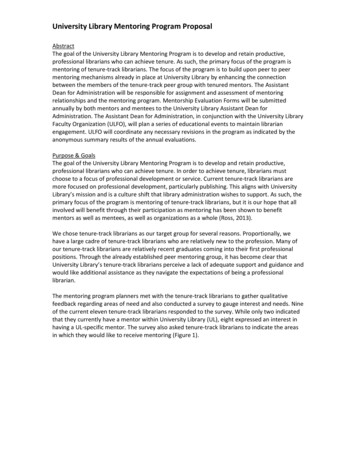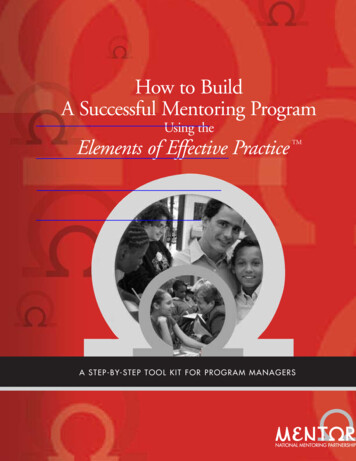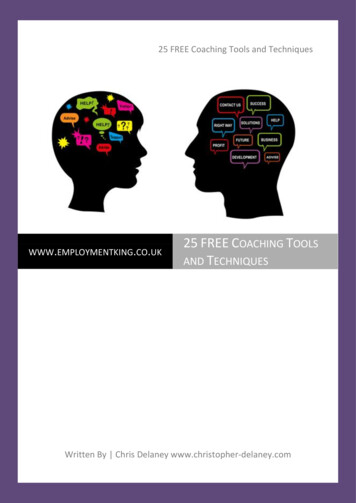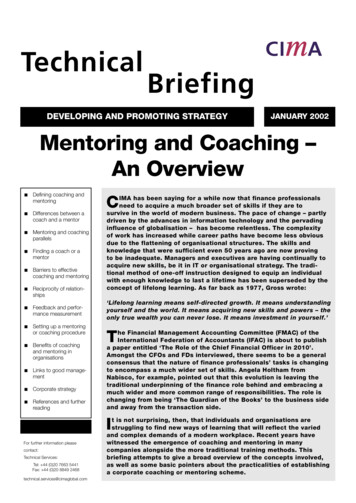
Transcription
TechnicalBriefingDEVELOPING AND PROMOTING STRATEGYJANUARY 2002Mentoring and Coaching –An Overview Defining coaching andmentoring Differences between acoach and a mentor Mentoring and coachingparallels Finding a coach or amentor Barriers to effectivecoaching and mentoring Reciprocity of relationships Feedback and performance measurement Setting up a mentoringor coaching procedure Benefits of coachingand mentoring inorganisations Links to good management Corporate strategy References and furtherreadingIMA has been saying for a while now that finance professionalsneed to acquire a much broader set of skills if they are tosurvive in the world of modern business. The pace of change – partlydriven by the advances in information technology and the pervadinginfluence of globalisation – has become relentless. The complexityof work has increased while career paths have become less obviousdue to the flattening of organisational structures. The skills andknowledge that were sufficient even 50 years ago are now provingto be inadequate. Managers and executives are having continually toacquire new skills, be it in IT or organisational strategy. The traditional method of one-off instruction designed to equip an individualwith enough knowledge to last a lifetime has been superseded by theconcept of lifelong learning. As far back as 1977, Gross wrote:C‘Lifelong learning means self-directed growth. It means understandingyourself and the world. It means acquiring new skills and powers – theonly true wealth you can never lose. It means investment in yourself.’he Financial Management Accounting Committee (FMAC) of theInternational Federation of Accountants (IFAC) is about to publisha paper entitled ‘The Role of the Chief Financial Officer in 2010’.Amongst the CFOs and FDs interviewed, there seems to be a generalconsensus that the nature of finance professionals’ tasks is changingto encompass a much wider set of skills. Angela Holtham fromNabisco, for example, pointed out that this evolution is leaving thetraditional underpinning of the finance role behind and embracing amuch wider and more common range of responsibilities. The role ischanging from being ‘The Guardian of the Books’ to the business sideand away from the transaction side.Tt is not surprising, then, that individuals and organisations arestruggling to find new ways of learning that will reflect the variedand complex demands of a modern workplace. Recent years havewitnessed the emergence of coaching and mentoring in manycompanies alongside the more traditional training methods. Thisbriefing attempts to give a broad overview of the concepts involved,as well as some basic pointers about the practicalities of establishinga corporate coaching or mentoring scheme.IFor further information pleasecontact:Technical Services:Tel: 44 (0)20 7663 5441Fax: 44 (0)20 8849 2468technical.services@cimaglobal.com
TECHNICAL BRIEFINGMENTORING AND COACHINGhere is no longer a point in one’s career where one can stop learning. People change jobsmuch more frequently nowadays and are faced with new responsibilities. Increased flexibility demands a broader spectrum of skills. This is especially true for finance professionals. Overthe last decade, their roles have been expanding to accommodate knowledge from other disciplines and overlapping with other organisational functions. But, whereas many will be givenenough support to advance the specialist side of their knowledge (whether in their workplaceor through professional bodies such as CIMA), most will be left with little time or opportunity toimprove their ‘soft’ skills such as communication, listening and team-work.Traditionally, these have not been the sort of skills accountants acquired through their professional or academic training or were able to utilise in their everyday work. The emphasis –until recently – had weighed heavily on the technical side. However, disregarding these skillscould leave finance professionals seriously disadvantaged in an environment that increasinglyfavours inter-functional, joined-up practices.TDefinitions of coaching and mentoringword of warning, however – there is no universal definition of either of these terms and therefore of the difference between them. There will inevitably be some whodisagree with the citations below. This is why we listthree similar though not identical sources.Despite what some HR consultants may tell you, coachingand mentoring are not recent phenomena. Edification ofsome kind has existed since Homer’s Mentor advisedOdysseus and thus lent his name to this very humanactivity. It was probably the goddess Athena herself, disguised as Mentor, who guided Odysseus’ son Telemachusin search for his father. Whatever the case, these ‘wise andtrusted counsellors’ have remained a feature of humaninteractions throughout history. The common noun‘mentor’ was first recorded in 1750. Interestingly, theetymology of the noun ‘coach’ is actually Hungarian. It isderived from the word for a vehicle or a carriage – the ideabeing that instructors carried their pupils!A recent article in the Financial Times (Clutterbuck, 2001)succinctly highlighted the main features of each as wellas their differences:Coaching is concerned primarily with performance and thedevelopment of definable skills. It usually starts with thelearning goal already identified.The most effective coachesshare with mentors the capability to help the learner developthe skills of listening to and observing themselves, whichleads to much faster acquisition of skills and modification ofbehaviour. Coaches also share with mentors the role ofcritical friend – confronting executives with truths no one elsefeels able to address with them.Of course, the connotations of both of these words havewidened significantly since they were first recorded.Their relatively recent adoption into HR theory andpractice has turned them into verbs, implying institutionalised training strategy. According to a survey of trainingmanagers by the CIPD in 1999, some 87 per cent of UKcompanies have some kind of a coaching or mentoringscheme. There is certainly no shortage of books, papersand conferences on the subject.Whereas the coach is more likely to approach these issuesthrough direct feedback, the mentor will tend to approachthem through questioning processes that force the executiveto recognise the problems for themselves. Mentoring isusually a longer-term relationship and is more concerned withhelping the executive determine what goals to pursue andwhy. It seeks to build wisdom – the ability to apply skills,knowledge and experience in new situations and to newproblems.There are many kinds of coaching and mentoring – fromlife coaching to mentoring schemes designed exclusivelyfor women or minorities to corporate peer-to-peermentoring or ‘buddy’ systems. In this briefing, we arespecifically referring to coaching and mentoring in anorganisational context, whether formal or informal.(There are significant differences between the formal andinformal approaches – see Ehrich and Hansford, 1999.)The Coaching and Mentoring Network summarises itlike this:Differences between a coach and a mentor So how do we define these activities? It is worth pointingout at the beginning that – although they are distinct inboth the format they adopt and the desired outcomes –there are sufficient similarities and overlaps to allow usto occasionally use them as synonyms in this briefing. ACoaching:focuses on achieving specific objectives, usuallywithin a preferred time period. Mentoring:follows an open and evolving agenda and deals witha range of issues.2
TECHNICAL BRIEFINGMENTORING AND COACHINGBenabou and Benabou (2000) present the differences in atabular form:Coachsion making, at whatever level of concern. It is not aboutgiving the right answers – the mentee probably alreadyknows them. This is why coaches and even mentorsdon’t have to have the same level of technical expertiseas their protégés. Their task is not to magically solve theproblems but to question how you go about looking forsolutions. It is not psychological mollycoddling or a substitute for hard work.MentorProtégé’s learning is primarilyfocused on abilitiesLearning is focused on attitudesTechnical or professional focusFocus on personal andprofessional developmentEffective use of the protégé’sexisting competenciesHelps the protégé realise his/herpotentialProfessional interaction withthe protégéMore interaction with an affectivecomponentInspires respect for his/herprofessional competenciesIs a role modelNeither are one-off events but processes with distinctevolutionary stages. As individuals attain specific goalsand learn new behaviours, the goalposts move accordingly until both participants are satisfied that the overallobjective has been achieved. That objective can be anything from a complete career change to learning a newprocedure.Finding a coach or a mentorThe best way of finding a coach or a mentor by far ispersonal recommendation. Failing that, you should consult bodies such as the International CoachingFederation, The UK College of Life Coaching, The LifeCoaching Academy and The Industrial Society’s Schoolof Coaching. They should all be able to point you in aright direction when it comes to finding a reputablescheme or individual.Adapted from Benabou and Benabou, 2000 by permission of John Wiley & Sons, Inc.To summarise, coaching is a little bit like having theprofessional equivalent of a fitness trainer – a specialistdedicated to working with you on specific goals andobjectives you would like to achieve for whatever reasons.Mentors, on the other hand, are more likely to havefollowed a career path similar to the one on which youare embarking. They are, therefore, charged with passingon their knowledge and expertise. Importantly, the knowledge transmitted in this way will contain invaluabledetails about organisational values, beliefs and culture thatare hard to acquire through formal training.It is worth noting that, because these are relativelynew professions, a certain amount of caution should beexercised before allowing staff to divulge professionaland personal information to a third party. Eventually,there will probably be a self-regulating code of practicesimilar to those in law or accounting.Most definitions emphasise that the difference betweencoaching and mentoring is in the length of time they takebut that is somewhat of a fallacy. Both are finite relationships, the average lifespan being six to eighteen months.Mentoring can develop into a friendship and, therefore, lastmuch longer, but there are inherent dangers in blurring therole boundaries which are discussed later in this briefing.TrainingAlthough there probably are certain personality traitsthat predispose individuals to professions such ascoaching or mentoring, the importance of trainingshould not be underestimated. No-one is born a mentor –a nurturing personality does not mean that you will beany good at running a mentoring scheme or coachingindividuals. Mentors and coaches, like everyone else,require training, supervision and feedback.Mentoring and coaching parallelsAs already mentioned, coaching and mentoring do sharesome common features. There could be occasions wherecoaches have to assume mentoring roles and vice versa.In most cases, they are both independent of line management relationships as that may stifle the openness andhonesty which is – or should be – at the heart of a successful dialogue. A coach or a mentor in effect becomes‘an accountability partner’ – working with your bestinterests in mind and bringing fresh insights to eitherspecific tasks or your career or private life as a whole.Finding a mentor as opposed to a coach is more problematic because the nature of the relationship is morepersonal. Some organisations adapt a laissez-faire attitude and leave it up to mentors and mentees to seek eachother out, as it were. Some set up mandatory schemeswhere a third party – usually someone from HR in consultation with line managers – assigns individuals tosenior members of staff who will act as mentors. Theprocess is sometimes turned on its head – reverse mentoring is where junior members of staff mentor seniormanagers, often on IT-related matters.Neither coaching nor mentoring is about teaching,instruction or being told what to do. As learning styles,their essence is facilitation. It should never be confusedwith simply giving advice or even feedback. Their role isto ask the right questions in order to generate individualself-awareness which can, in turn, lead to informed deci-When it works, the benefits of a structured approach areclear – all the tacit, difficult-to-capture knowledge is3
TECHNICAL BRIEFINGMENTORING AND COACHINGreleased and passed on to the next generation. However,there is a danger that such an interventionist approachcould result in personality clashes that undermine thewhole basis of a mentoring relationship. (See the article inHarvard Business Review, Nov/Dec 2000 entitled ‘Too OldTo Learn?’ about the perils of reverse mentoring. You canobtain the article through CIMA’s Technical AdvisoryService.) In either case, good preparation on both sides iscrucial, as is an awareness of potential problems. Unfortunately, there has not been a plethora of studies onthe best ways to match individuals in mentoring (andcoaching) relationships. The little research that does existseems to point to similarities between participants inbeliefs, values and life goals. However, this ‘attraction tolike’ seems only to work at the level of general interestsand background (whether social, cultural or educational).It does not mean that mentors and mentees need to haveidentical management or learning styles. Quite the opposite – it seems that when this was the case, mentees soonlost interest as they perceived there was little new thatcould be learnt.Reciprocity of relationships the incorrect matching of mentors/coaches and learners;the lack of top-down support;the resentment felt by those not involved in thescheme or the perception of favouritism;the creation of false promotional expectations;the overdependence of the mentor or mentee;gender issues;blurring of role boundaries and so on.It is worth remembering that rather than being one-sided,the best mentoring relationships are reciprocal. You don’tsimply turn up once a fortnight (or however often) andlisten to some words of wisdom that will change your lifeforever. Both participants must play an active part, eventhough the onus is on the person being mentored orcoached. A good coach or mentor will set tasks andobjectives that need to be tackled before each meeting. Itis then up to the individual to complete them, reflectupon them and try to apply them in practice. If there isno input, the coach or mentor might decide to terminatethe relationship.Whatever matching approach you decide to take, makesure you meet the coach or the mentor before the processgets under way as good rapport between participants isessential. (This is somewhat less true for coaching as it ismore about action planning and setting measurableobjectives and less about learning by example.)A lot of popular literature on the subject focuses on therecipient of mentoring or coaching as if the relationshipexists solely for their benefit. In fact, people choose tobecome coaches or mentors because they themselves getsomething out of it. Many would say that they enjoybeing involved in someone else’s development and thatthey enjoy nurturing young talent. Those who aremanagers themselves see it as a way of becoming betterat their job by developing their listening skills and theability to see things from a different perspective. Becauseit bypasses direct line management, mentees are morelikely to be honest about their work problems – and thusprovide an invaluable insight into management roles.(The interaction between coaching and mentoring andmanagement is discussed towards the end of this briefing.)With one-to-one mentoring, it is easy to establish earlyon whether sufficient empathy is present. Even on acorporate level, those in charge of setting up a mentoringor coaching scheme should consider how the potentialcandidate(s) fits in with the overall organisational cultureand the individuals likely to be involved.Good rapport is also important because coaching andmentoring are powerful relationships that are open toabuse from both sides. The participants need to agreeclear rules and boundaries before the process begins andstick to the same parameters throughout. Unless there istotal trust, openness and commitment to confidentiality,the scheme will quite simply be unsuccessful. In addition, it should always be a voluntary programme – noone should be coerced into being coached or mentored.Feedback and performance measurementCompanies should ensure that there is a proper feedbackmechanism at the end of any coaching or mentoringundertaken. This should enable an honest evaluation ofits success – or otherwise – and provide the relevantinformation for any follow up action. Feedback shouldideally be sought at regular intervals. This creates atimely opportunity to identify potential trouble spots andrectify any mistakes. Many coaches ask their clients to fillin questionnaires but feedback can also take the form of adiscussion, formal or otherwise. It should involve the HRdepartment or the scheme champion, if one has beenappointed. There should be a report at the end detailingresults and recommendations, based on the analysis ofresources (including time and money) and participants’feedback.Barriers to effective coaching and mentoringThere is, as Long (1997) described it, a ‘darker side ofmentoring’, despite the fact that most of the literature onthe subject tends not to mention it. The majority of itconcerns issues of organisational culture – i.e. the contextin which mentoring and coaching takes place – and theinterpersonal issues between the participants of the programme and the rest of the company. There is no spacehere to go into details of potential problems but someissues to bear in mind are (adapted from Ehrich andHansford, 1999):4
TECHNICAL BRIEFINGMENTORING AND COACHINGIt is important that the usual constraints of structuredplanning and control are applied to coaching/mentoringschemes. Although it is more difficult to gauge successdue to all the intangible factors involved (people’sperceptions, attitudes, etc.), some sort of performancemeasurement and cost–benefit analysis is necessary.Companies should produce hard data – whether qualitative or quantitative – about the success or failure of theprogramme. There must be clear objectives from theoutset, against which progress can be measured. Costsshould be assessed during the implementation stage.Some companies link overall goals to a competencyframework, with the annual performance rating of eachmentee as a measure (Clutterbuck, 2000/01). Somecompare costs of the mentoring programme to costs thatwould have been incurred using some other trainingactivity to reach the same objective. Similarly, costs canbe compared to the financial results of reaching a predefined target – for example, saving achieved in reducingcosts of conflicts (Benabou and Benabou, 2000).Coca-Cola’s coaching programme, although less formal,is nevertheless structured through five different categories which provide a flexible approach for different situations. They are modelling, instructing, enhancingperformance, problem solving and inspiration and support.Both coaching and mentoring are used as tools to supporthuman resource development strategy and, therefore, thewider objectives of value generation within the company.They are thus directly linked to long-term corporatestrategy.Benefits of coaching and mentoring inorganisationsWhy have coaching and mentoring become so popularrecently? Part of the answer surely lies in what the management guru Charles Handy once said would become themajor challenge of our time – managing individuals andnot human resources. Companies like to say that peopleare their greatest asset but all too often – as in Dilbertcartoons – they slip to the ninth place behind carbonpaper. To stem the flow of valuable intellectual capital,companies are trying to find new ways of retaining andmotivating staff and thus increasing their productivity.Setting up a mentoring or coaching programmeThe mentoring and coaching programme in an organisation could be represented as consisting of the followingphases:Recruitment and retentionCoaching and mentoring can be a useful tool in recruitment and retention. Companies tend to spend a lot ofmoney on anything from bottles of wine to full conciergeservices, forgetting that such incentives ultimately don’tstop many people from moving on. What does is havinginteresting and fulfilling work to do and being treated asvaluable individuals. By addressing personal as well asprofessional development needs – and thus looking afterthe individual rather than the amorphous humanresources – coaching and mentoring can keep turnoverrates in check. Staff feel valued and the management isclearly communicating its commitment to training anddevelopment. In a climate where internally-generatedintellectual assets play a key role in creating competitiveadvantage, the bottom line will suffer unless you lookafter your staff.Objectives and links to organisational strategy"Identification and matching of participants"Processes and systems needed to supportmentoring or coaching"Evaluation and feedbackContinuous learningCompanies adapt this basic programme to their own needsand objectives. A case study of Coca-Cola (Veale andWatchel, 1996), for example, showed that their mentoringprogramme follows a ten-point procedure outlined below:1.2.3.4.5.6.7.8.9.10.Part of the reason for the surge in popularity also comesfrom our changing attitudes to work and learning. Asmentioned at the beginning, lifelong learning has replacedthe idea of one-off tuition. Coaching and mentoring,which can be undertaken at any stage in one’s career, areperfectly suited to replace outdated learning styles. Theycan be adapted to all levels within a company – fromyoung managers seeking technical or specialised knowledge to senior executives requiring motivational training.CEOs in particular can benefit from having a coach or amentor – or both. Life can be lonely at the top, which iswhy it is helpful to have someone with whom you cantalk without fear of embarrassment or appearing weak orindecisive.mentee identified;identifying developmental needs;identifying potential mentors;mentor/mentee matched;orientation for mentors and mentees;contracting;periodic meetings to execute the plan;period reports;conclusion;evaluation and follow up.5
TECHNICAL BRIEFINGMENTORING AND COACHINGTraining versus mentoring and coachingOf course, we are talking about successful schemes butthere are plenty of opportunities for things to go wrongas we have already mentioned. From personality clashesto breaches of confidence, the consequences of a falloutare worth bearing in mind. There is no substitute forthorough initial preparation.Companies are beginning to question the value of shortterm training programmes. They are designed to instilthe company ethos in a relatively artificial environmentand, therefore, frequently produce short-term benefits.The same scenario is probably repeated in thousands ofoffices throughout the country – senior managers go off‘tree-hugging’ for a few days, come back full of enthusiasm and within five days things go back to normal.Mentoring and coaching – because they focus on theindividual and tend to be more long-term – are capableof initiating a real change in behaviour rather than justrhetoric about it. They are not a substitute for trainingbut should be used in conjunction with it.There will always be those who are sceptical about thevalue of coaching and mentoring. Some equate it withtherapy or counselling and are, therefore, suspiciousabout its appropriateness for the workplace. The truth is,they are nothing like therapy for one simple reason –whereas therapy focuses on the past, coaching and mentoring are exclusively concerned with the future.In Hale’s (1999) research about mentoring, menteescategorically denied that the outcomes could have beenachieved through training alone. In fact, one US studyshowed that while training alone increases productivityby 22.8 per cent, for training combined with coaching thefigure was nearly 90 per cent. Perhaps the skills acquiredin this way could, as Hale suggests, be the bridgebetween training and implementation. They changepeople’s attitudes by addressing precisely the issues thatnormally act as barriers to putting newly acquired skillsinto practice – such as confidence or risk-taking.Links to good managementThe aims of coaching and mentoring are essentially thesame as those of good management. Both try to make themost of people. The characteristics of a good mentor canbe narrowed down to the following (Hale, 1999): listening, openness/self-disclosure;lateral thinking, challenging;bravery in involving the mentee in certain new workexperiences;making time available;enthusiasm.Soft skills acquisition As mentioned at the beginning, many of the skills thefinance professional of today needs are the so-called softskills such as creativity, the ability to manage change, teamwork and so on. By their very nature, these are the skillsthat are difficult – some would say impossible – to teach inany kind of a formal training programme. This is wherecoaching and mentoring can be beneficial as part of therange of approaches used by organisations. In an interviewfor the forthcoming FMAC paper ‘The role of the chieffinancial officer in 2010’, John Connors, the Chief FinancialOfficer of Microsoft, said that ‘CFOs will have to havemore coaching in communication skills. They will have tobecome much more effective in framing their company’sstory consistent with the company’s financial story’.Clearly, these are not overly ambitious and should, infact, be a part of every manager’s toolkit. Unfortunately,they very rarely are in practice.Some writers and practitioners go as far as to advocatethat every manager should be a coach to his or her staff.The term management to them implies a command-andcontrol relationship unsuitable for a modern workplace –flatter organisational structures demand more fluid working alliances. For example, Murphy (1995) calls for a general move from management to coaching. The so-called‘generative coaching’ is about understanding people intheir wholeness and then acting on the basis of that understanding. The aim is to establish a mutual learning processwhere there is no one right mental model but there isenough space to consider various choices and possibilities.Finally, coaching and mentoring are actually cost-effective ways of making long-term changes in your organisation’s culture and operations. A study of Fortune 1000companies who have implemented executive coachingshowed that the average rate of return on investment wassome 5.7 times the actual cost. For internal mentoringschemes, the figure is likely to be even higher.Coaching style of managementOne could in fact maintain that managers already possessthe capacity to influence the performance and learning ofothers. Used actively, that can in itself be called coaching.Benefits of mentoring programsMentee/protégéCareer advancementPersonal supportLearning and developmentIncreased confidenceAssistance and feedbackNew ideasAdapted from Ehrich and Hansford, 1999MentorPersonal fulfilmentAssistance on projectFinancial rewardsIncreased confidenceRevitalised interest in workNew ideas6OrganisationDevelopment of managersIncreased commitment to the organisationCost effectivenessImproved organisational communicationChange managementLeadership development
TECHNICAL BRIEFINGMENTORING AND COACHINGIts boundaries are likely to be narrower than where thereis no direct line management crossover but there arenevertheless sizeable benefits. Being coached and beingtaught how to coach can demonstrate to young managersthat looking after and nurturing your staff takes morethan a quarterly team meeting and a pat on the back.organisation. Mentoring and coaching are used tostrengthen the link between development and strategythrough a threefold approach (Veale and Watchel, 1996):1. to strengthen the link between business strategy anddevelopmental focus;2. to involve leadership of the organisation in all aspectsof development;3. to use a variety of developmental tools to match personal and organisational needs better.It is no surprise that some managers are reluctant toadopt coaching into their management style. Because itrequires total honesty and surrendering your personalagenda, it inevitably detracts from the mystique and‘importance’ of being a manager.The lack of clear commitment from the top and the lackof conducive organisational culture can mean that eventhe best thought out schemes are destined to fail. In thatcase, coaching and mentoring become the latest fad to beartificially grafted onto the usual practices. Some organisations are simply not ready for it. For example, if there isnowhere to be promoted within the company despite thenewly acquired skills and competencies, it is bound toresult in frustration (Ehrich and Hansford, 1999). However, mentees’ expectations also need to be managed. It isa balancing act that can be achieved with sound planningand assessment.A coaching style of management should be the adoptionof a non-judgmental questioning method used toempower staff to reflect on their own actions and behaviour and therefore internalise any necessary changes. Itis the opposite of the command and control paradigmwhich has been so prevalent in management. A part ofevery manager’s job, in other words, should be this facilitating process that consists of questioning, rather thaninstruction.There does, however, need to be a very
life coaching to mentoring schemes designed exclusively for women or minorities to corporate peer-to-peer mentoring or ‘buddy’ systems. In this briefing, we are specifically referring to coaching and mentoring

